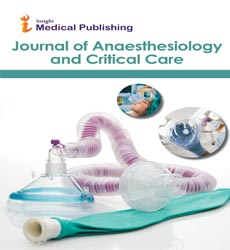A Prospective Observational Comparative Investigation of the Cardiopulmonary Consequences of Extended Surgical Abdominal Retractors Application During General Anaesthesia.
Ahmed S. El-Hefnawy*
Department of Anesthesiology, University of California, USA
- *Corresponding Author:
- Ahmed S. El-Hefnawy
Department of Anesthesiology, University of California, USA
E-mail: ahmedelhefnawy@gmail.com
Received Date: September 03, 2021; Accepted Date: September 22, 2021; Published Date: September 29, 2021
Citation: El-Hefnawy AS (2021) A Prospective Observational Comparative Investigation of the Cardiopulmonary Consequences of Extended Surgical Abdominal Retractors Application During General Anaesthesia. J Anaesthesiol Crit Car. Vol.4 No.1:03
Commentary
The goal of this study was to determine the cardiopulmonary load of multiple retractors application during supine versus lateral abdominal procedures, based on the idea that increasing abdominal pressures can impair pulmonary compliance and cardiac performance. During both lateral and supine abdominal operations, we expected that the use of surgical ring multiple retractors would impair pulmonary and cardiac functioning. Surgical retraction causes considerable short-term deficits in lung compliance and cardiac output, especially in the lateral-kidney position, compared to the supine position.
Introduction
Postoperative cardiac and pulmonary problems after general anaesthesia are common, with rates ranging from 3–7.9%. Re-intubation, pulmonary failure, edoema, infection, and collapse are the most common complications with pulmonary surgeries. After abdominal surgeries, postoperative respiratory failure increases early perioperative mortality by a factor of ten. Airway edoema, obesity, tumours, supine position, and extended surgical retractors application are all implicated predictors. The use of surgical retractors for an extended period of time has been linked to a higher risk of postoperative pulmonary complications. A major cause of respiratory failure has been identified as pulmonary atelectasis. It begins minutes after general anaesthesia induction due to a drop in regional trans-pulmonary pressure in dependent lung areas, and it worsens as a result of the stress reaction to the surgical incision. Reduced compliance in de-recruited areas leads to over-inflation of aerated lung tissue in non-dependent areas, resulting in higher trans-pulmonary pressure (volu-trauma); cyclic lung de-recruitment leads to low-volume lung injury (atelectotrauma); release of local pro-inflammatory mediators from surgical incision stress response, tissue trauma by surgical retractors, and infection all contribute to (bio-trauma).
The influence of self-retaining multiple abdominal retractors on cardiac and pulmonary function during lateral and supine surgical positions is still unknown. Finding an answer to this topic will help anesthesiologists make better decisions about anaesthetic risk, ventilatory and fluid management during various surgical positions while using self-retaining multiple abdominal retractors. During both lateral and supine abdominal operations, we expected that the use of surgical ring multiple retractors would impair pulmonary and cardiac functioning. The researchers wanted to see how dynamic and static lung compliance, cardiac index (CI), PAWP, oxygen delivery (DO2), and peripheral oxygen saturation (SpO2) changed before, during, and after open abdominal surgery for nephrectomy and cystectomy in the lateral-kidney and supine positions, respectively.
In terms of compliance and hemodynamic changes, we found no statistically significant differences between the two surgical techniques before and after the surgical retractor were applied. The supine position, on the other hand, is related with greater Cdyn, Cstat, and SaO2 levels and a lower increase in PAWP values when compared to the lateral kidney posture. The depressive effect of abdominal self-retaining retractors on pulmonary compliance can explain our findings, which show a statistically significant decrease in Cdyn and Cstat, as well as a statistically significant increase in PAWP, over the course of the study, despite no significant intergroup difference in Cdyn and Cstat between lateral and supine positions. The differences between the two operative positions were just temporary, and they returned to normal after the retractor was removed. Similarly, researchers found that shifting from a supine to a lateral position reduced COP by 20% (p 0.01). This was due to an increase in systemic vascular resistance and a decrease in venous return. We did not assess these parameters in our investigation because of a local institutional policy prohibiting the use of invasive pressure monitoring during these surgical operations except in patients with substantial comorbidities, who were excluded.
There are a few flaws in our research. To begin, we looked at two different surgical procedures (cystectomy and nephrectomy) that may have non-comparable conditions such as surgical incision type and extent, as well as surgical process length. More individuals with more identical surgical procedures will be needed in future cross-sectional studies. Second, the European and North American guidelines for routine perioperative monitoring, which include objective neuromuscular block monitoring. Unfortunately, at the time of the study, these monitors were not available at our institution.
Open Access Journals
- Aquaculture & Veterinary Science
- Chemistry & Chemical Sciences
- Clinical Sciences
- Engineering
- General Science
- Genetics & Molecular Biology
- Health Care & Nursing
- Immunology & Microbiology
- Materials Science
- Mathematics & Physics
- Medical Sciences
- Neurology & Psychiatry
- Oncology & Cancer Science
- Pharmaceutical Sciences
